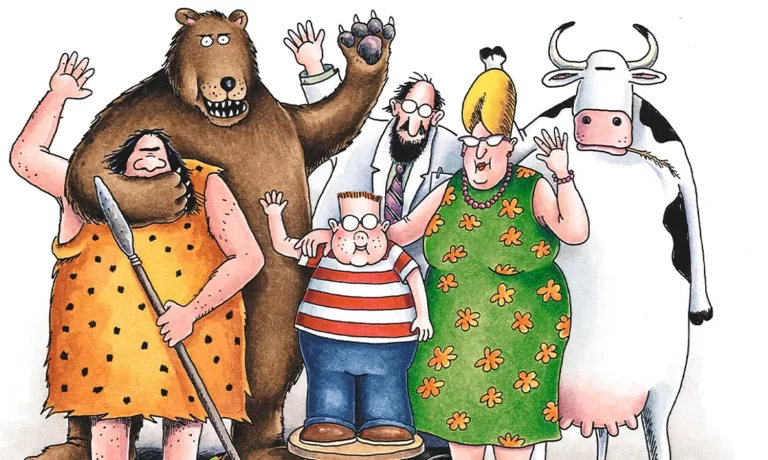No products in the cart.
The Far Side
The Far Side – A Comic Strip We All Love
Who is the creator of The Far Side?
Gary Larson is an American cartoonist known for his comic strip “The Far Side”. The comic strip was published from 1979 to 1995 and became a well-known cultural phenomenon in the United States. Larson was born in Tacoma, Washington, USA. He began drawing comics at a young age and was inspired by other cartoonists like Don Martin and Gahan Wilson.
The Far Side is a single-panel comic strip known for its surreal, surprising, and satirical humor. Larson uses images of animals and nature to create humorous situations and reflections on various life issues. The comic strip was published in over 1900 newspapers in 50 countries and translated into 25 languages. Larson received numerous awards for The Far Side, including the Reuben Award in 1985 and a Pulitzer Prize in 1992.
Even though the comic strip technically ended, The Far Side still has fans all over the world. A wide variety of fans, too.
All about The Far Side
The history of its inception and the developmental process
- Publication (1979–1995)
The Far Side made its debut on January 1, 1980, in the Chronicle, and shortly afterward, Chronicle Features began offering it to other newspapers. Although initially featured in only four papers in 1982, the number of newspapers carrying The Far Side increased to eighty by 1983 and reached two hundred by 1985. Larson started by drawing six cartoons a week, sent them to newspapers several weeks in advance, and later increased his workload to seven cartoons a week.
He took a hiatus from October 1988 to January 1990 to travel abroad and study jazz guitar with Jim Hall. When he resumed work on The Far Side in 1990, Larson negotiated to reduce his workload to five cartoons a week. The final “Far Side” comic was published in newspapers on January 1, 1995. In October 1994, Larson wrote a letter to his readers explaining that he was ending the series due to “simple fatigue” and to prevent The Far Side from falling into the “Graveyard of Mediocre Cartoons”.
Larson also expressed a desire to pursue a career as a jazz guitarist. During its 15-year run, Larson produced a total of 4,337 “Far Side” cartoons. By the time it concluded, the series was featured in over 1,900 newspapers and translated into 17 languages. Universal briefly re-syndicated The Far Side for a three-month period in late 2003 to promote the release of the anthology The Complete Far Side: 1980–1994, and many newspapers continue to publish reprints.
- Hiatus (1995–2019)
Larson disapproved of the internet distribution of his cartoons and requested that fans not share his work online, explaining that it was too personal and valuable for him to allow others to “take control of it.” Due to this, Universal’s online service GoComics did not provide The Far Side cartoons. In at least one instance, Larson sent a cease and desist letter to a comics aggregation site for posting The Far Side online.
While an official “Far Side” website existed, it primarily offered information related to the comic and published books but did not feature any strips. In 2003, Larson created a cover for the November 17 edition of The New Yorker magazine, the Cartoon Issue, an offer he could not refuse.
- Online Revival (2019–Present)
On September 13, 2019, the official “Far Side” site underwent a significant redesign, hinting at “[a] new online era of The Far Side”. The full site was launched on December 17, 2019, offering a “daily dose” of randomly selected “Far Side” comics, a weekly themed collection, and additional material including artwork from Larson’s sketchbooks. In an open letter, Larson expressed hope that the official online presence of The Far Side would prompt sites hosting his comics to take them down and direct readers to the official site. Larson clarified that while he did not plan to create regular “Far Side” comics, he might occasionally include new material when updating the site.
On July 7, 2020, Larson released new “Far Side” strips on the website for the first time in 25 years, marking a transition to using a graphics tablet instead of pen and paper. In a related post, Larson explained that frustration with his pens clogging from lack of use on the rare occasions when he drew following his retirement led him to experiment with a digital tablet. The new possibilities offered by digital media reignited his enjoyment of drawing. Larson emphasized that he was not resuming the production of daily cartoons but rather exploring, experimenting, and trying new things.
Content and style
The Far Side employs a distinctive storytelling format, primarily relying on a single vertical rectangular panel, which is occasionally divided into smaller sections for narrative purposes, containing typed captions or dialogues underneath. In some instances, speech balloons are used for conversations. Certain strips, especially those published on Sundays, are double-sized, colored, and feature handwritten captions.
Gary Larson’s series is known for its unconventional, often surreal style of humor, setting it apart from traditional newspaper cartoons. It has been described as “an anomaly” by Brigham Young University professor Kerry Soper and characterized as “surreal, random, and occasionally very dark” by ComicsAlliance. Larson’s dark sense of humor was influenced by his family, particularly his older brother Dan, who used to play pranks on him that exploited his fears. Larson also drew inspiration from personal experiences, the magazine “Mad”, and his favorite childhood book, “Mr. Bear Squash-You-All-Flat”. He often used animals in human roles to mock the human condition, and the themes of fear and horror comedy prevalent in the strip reflected the era in which it was produced.
 Recurring themes in The Far Side include scenarios like people stranded on desert islands, encounters with aliens, depictions of Heaven and Hell, life in caveman times, and medieval dungeons. Animals, especially cows, are frequent subjects. Larson deliberately tackled taboo subjects in his cartoons to make personal statements. However, he faced resistance from his editors, who refused to publish strips they deemed indecent, offensive, or difficult to understand. Some examples that didn’t make the cut included cowboys roasting a horse over a fire out of desperation and a bird eating scrambled babies.
Recurring themes in The Far Side include scenarios like people stranded on desert islands, encounters with aliens, depictions of Heaven and Hell, life in caveman times, and medieval dungeons. Animals, especially cows, are frequent subjects. Larson deliberately tackled taboo subjects in his cartoons to make personal statements. However, he faced resistance from his editors, who refused to publish strips they deemed indecent, offensive, or difficult to understand. Some examples that didn’t make the cut included cowboys roasting a horse over a fire out of desperation and a bird eating scrambled babies.
These controversial themes and sensitive images often sparked debates and attention, especially in an era when comic art was expected to adhere to certain rules and limits. Gary Larson often faced opposition from his editors who refused to publish cartoons they deemed inappropriate or easily misunderstood.
However, these controversies also contributed to the fame of The Far Side and created a unique appeal. Larson’s courage in exploring forbidden and unconventional topics made this comic strip distinctive and attention-grabbing. His imaginative drawings have stimulated readers’ thinking and challenged their perspectives on the world around them.
While Larson occasionally employed recurring stereotypical characters like a woman with a beehive hairdo, he intentionally left them unnamed and didn’t imply they were the same characters from one cartoon to another. He preferred not to create a character-based series; instead, the characters served as tools to enhance the humor of each individual comic.
The influence
The Far Side, with its uniqueness and boldness in content, has had a significant impact on the American comic art world. Firstly, this comic strip played a pivotal role in altering the American comic style. Before the emergence of The Far Side, many American comic strips relied on fixed characters and repetitive scenarios. Gary Larson, the creator of The Far Side, pushed American comic art in a new direction by crafting distinctive short stories not tied to recurring characters, opening the door to limitless creativity.
Furthermore, The Far Side introduced a new wave of strangeness, surrealism, and philosophy into comic art. Larson often placed animals and nature in unusual situations, offering a fresh perspective on the world. The humor in this comic often lies in the humorous and creative combination of content and imagery.
Lastly, The Far Side has been a source of inspiration for many generations of artists and writers. Larson’s unique creativity demonstrated that comics could serve as an artistic medium for expressing personal opinions and philosophies. Many comic authors who came later were driven by the creativity of The Far Side and applied similar styles and ideas to their works.
Related article: Our Top 10 Picks For The Far Side Fans
The Far Side – American culture shaped by unique humor
Gary Larson and his work, The Far Side, have achieved significant milestones in the world of comics. The Far Side not only created a new wave in American comic art but also became a symbol of unique creativity and humor.
With over 4,000 unique comic strips, Gary Larson changed the approach to American comics. Instead of relying on recurring characters, he opened up a diverse and whimsical comic world, where animals, humans, and nature interact in unusual situations. The combination of surreal and philosophical content with a simple drawing style made The Far Side stand out and elevated Gary Larson to an important position in the comic industry.
The significance of The Far Side in American culture cannot be underestimated. This work created a new wave in humor and comics, challenging traditional rules and boundaries. It paved the way for comic authors to explore unlimited creativity and express personal views through art. At the same time, it contributed to shaping a significant part of American cultural vision, demonstrating America’s determination to explore and evaluate the world from a humorous and sometimes eccentric perspective. The Far Side and Gary Larson have become an icon of unique creativity in American art and culture.


































